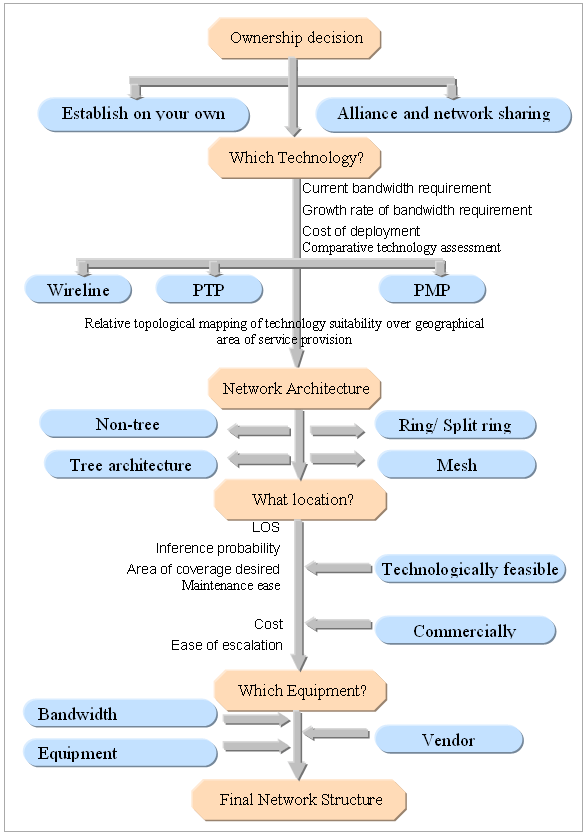|
Executive Summary (Abridged)
This version of the Executive Summary from Pioneer
Consulting’s new report, “Wireless Backhaul 2005: Worldwide
Market Opportunities in Cellular Markets” is available as a
free download from Pioneer’s web site.
It is an abridged version of the full Executive Summary
contained within the report and provides information on the
objectives and scope of the report, the methodology used, and
the key issues discussed.
Further
information can be obtained by e-mailing
info@pioneerconsulting.com.
1. Report Aims
The purpose
of this report is to investigate the adoption of wireless
backhaul in cellular markets in order to evaluate and predict
the market opportunity for wireless backhaul solutions during
2004-10.
The report
comprises three core sections: Technology Overview, Market
Overview and Market Opportunity Forecasts through 2010.
2. What is Wireless
Backhaul?
Backhaul is
the network component that connects the subscriber access
section of the network with its core switching and management
elements. It accounts for about one-fifth of the overall
mobile network cost.
Network
operators can choose from a variety of backhaul technologies,
such as wireless, leased wireline, fiber and satellite. The
principal factors governing the choice of backhaul medium
include the cost of the network, the capacity required, and
other issues related to installation and maintenance.
The term
‘wireless backhaul’, as used in this report, refers to a
microwave trunk circuit between a Base Transceiver Station
(BTS) and a Base Station Controller (BSC) or a Mobile
Switching Center.
Microwave
network configurations include Point-to-Point (PTP) and
Point-to-Multipoint (PMP) technologies. The choice of a
network configuration depends on the network capacity
required, geographical and topographical conditions and the
expansion planned for the future.
3. Comparative Analysis of
Backhaul Technologies
3.1 Performance Analysis
The report
compares the main wireless backhaul technologies, i.e. PTP,
PMP, Leased Line, and Fiber, in terms of the following
performance parameters :
-
Capacity
-
Capital Cost
-
Operating Cost
-
Flexibility/ Scalability
-
Time to Market
|
|
3.2 Cost Analysis
Based on
global average cost estimates across different frequency
bands, Pioneer’s analysis shows that wireless backhaul
technology generally proves to be more cost-effective than
leased lines in the long run.
The report
then goes on to compare capital and operating expenditures
associated with PTP and PMP and finds that, even taking into
account the additional initial capital cost of a PMP hub, a
network only requires a handful of links before the PMP
solution becomes more cost-effective.
4. Demand Drivers and
Suppressants
The overall
growth in the cellular market (primarily led by a rapid
increase in the number of cellular subscribers in recent years
and the growth in demand for data-intensive services) has been
a principal driver for new infrastructure deployments.
Wireless backhaul offers significant technological and
commercial advantages over other backhaul technologies, which
has prompted operators to replace leased line backhaul
networks with microwave systems. However, certain
technological and regulatory constraints may hamper the wider
adoption of wireless backhaul technology by network operators.
Exhibit 1
: Deployment Strategies

Source : Pioneer Consulting, LLC
5. Market Opportunity
5.1
Methodology
The demand
forecasts for market opportunity of wireless backhaul utilize
Pioneer Consulting’s proprietary modeling procedures. It takes
into account the qualitative factors that drive or suppress
the growth of wireless backhaul in various regions and the
differences in rate of adoption of technology. These factors
are quantified using various curvilinear extrapolation
techniques to produce estimates for market size.
For this
forecast model, an estimate of cellular subscribers through
2010, using the Gompertz curve, is taken. The calculated
cellular subscriber base is then used to estimate the total
market for base stations. The market opportunity for wireless
backhaul is calculated as a function of the total addressable
BTS market and the penetration of wireless technology in this
market.
5.2
Sources
The
information contained in this report was collected through
primary and secondary research. The primary research for this
report includes personal interviews with vendor
representatives, equipment suppliers, network operators and
service providers in the mobile wireless industry.
The
secondary research for this study draws upon a variety of
sources, including the Federal Communications Commission
(FCC), the International Telecommunication Union (ITU), the
Securities and Exchange Commission (SEC), proceedings from a
variety of international trade seminars and technology
journals. Secondary research also included a review of current
periodical research on international telecommunications and
mobile wireless networks available in print and on the
Internet.
5.3
Findings
This report
assesses the global market opportunity for base stations in
the period 2004-10 and finds that wireless backhaul
installations are expected to increase at a compounded annual
growth rate (CAGR) of 5%. The Asia Pacific region will lead
the global BTS market, followed by Europe and North America. A
full breakdown of the market opportunity by region, in terms
of sales units and US dollar value, is provided within the
report. Comparing the various technologies, Pioneer is
forecasting significant growth in the number of PMP
installations although its share of the overall market will
remain fairly low. |